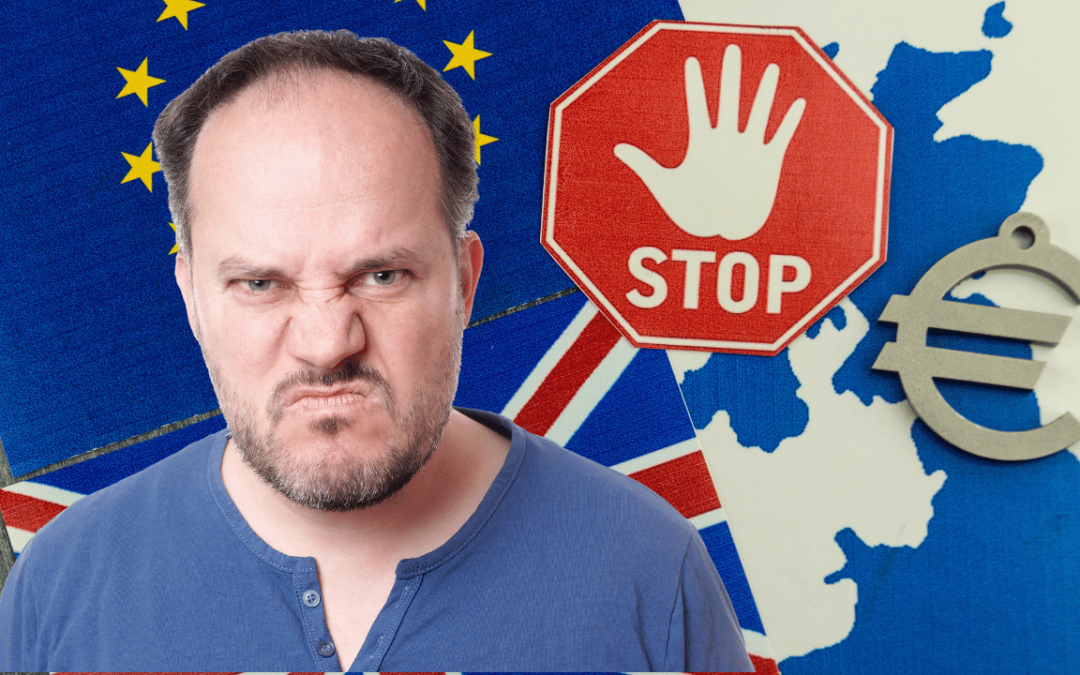Unlocking the greatest mystery of Spanish driving: how to use roundabouts! I take you on the drive of your life to discover the best way to navigate those circles of confusion and avoid collisions, accidents, and sudden death on the roads of Spain.
Prefer to watch the video? Click the picture below.
How do you use roundabouts in Spain?
It’s the greatest mystery of living here, and I’m going to unlock it for you. Here’s an idiot’s guide to using these circles of confusion and death! 🤣
So many people on social media say ‘Spain has different rules from every other country’ in the world!’ When you live in a tourist area like I do, full of people from different countries that either have different rules or no roundabouts at all, it’s no surprise to find out that 10 per cent of traffic accidents in Spain happen on roundabouts. Between 2015 and 2019 there were 45,000 accidents on roundabouts, in which 317 people died and 58,000 were injured.
When you look at those rules and read different pieces of advice, some of them from the police themselves, they’re not always completely clear.
The DGT tell us that two thirds of drivers in Spain don’t know how to use a roundabout correctly! So it’s not just foreigners who are confused. Even some of the people that understand the rules don’t follow them all of the time.
But let’s not waste time having a go at each other for being idiots, let’s just assume we all are, and work out the best way to survive.

Here goes then, first of all there are three basic rules to follow. We’ll get to the intricacies in a minute, but here’s…
Rule number 1
You must drive anti-clockwise around a roundabout.
For those of you who aren’t capable of astral projection or can’t imagine hovering above the roundabout as you approach it, anticlockwise means you head to the right to get onto the roundabout and then you curve round to the left. You’ll notice the exits are on your right.
So that’s all very straightforward, even for UK drivers who are used to going the other way. Once you get used to it in your head, it’s a piece of cake.
Rule number 2
Traffic already on the roundabout has priority.
Remember, vehicles on the roundabout will be approaching from your left, so as you approach the roundabout and slow down, that’s the way you should be looking.
But make sure you’re also looking at the car in front of you, and assume they’re going to stop even if there’s no one on the roundabout, because pausing there is a really good thing to do.
Then, when they start to pull away, assume that they’re going to stop again. That way you won’t shunt them while you’re looking left. That’s the first big cause of accidents at roundabouts. But that’s really no different to what happens in other countries.
Rule Number 3
You must only leave the roundabout from the outside lane.
Now you might think it’s obvious to say ‘only leave from the outside lane’ but what it means is you shouldn’t cut across the outside lane straight to the exit.
What you’re supposed to do is move to the outside lane first, in plenty of time before the exit, then you’re in the correct lane to take the exit properly.
This rule, combined with which lane you’re supposed to be in to approach the roundabout (and how you’re supposed to use your indicators) is the reason why there are so many accidents.
Here’s a burning question, which lane should you be in when approaching the roundabout?
Technically speaking, the right hand lane is the driving lane, and any lanes on the left of it are for overtaking, which also means that the inside lane of the roundabout should only be for overtaking too because it’s the left hand lane.
Imagine that the curve of the roundabout is just a continuation of the road, then all that makes sense. You just use the right hand lane, then turn off to your right when you get to your exit.
But, in practise (and also in the guidelines given out by the police) you’re advised to approach the roundabout in the right hand lane if you’re heading for the first or second exit, but if you’re taking the third or fourth exit, you’re advised to move into the left hand lane as you approach the roundabout.
This can also act as a signal to other drivers of which exit you intend to use.
Then, like I said before, as you’re going round the roundabout, you move into the outside lane ready to exit.
If there’s no space to do that because of other vehicles taking up the outside lane, the correct thing to do is keep on going round the roundabout until you can move outwards safely.
Of course what happens in practise is that some drivers approach in the left hand lane and cut straight across to go straight on. And usually they’re the ones going too fast to stop if someone joining from the right pulls out. That’s when the big accidents happen.

Indicating.
This is something that 60% of Spanish drivers don’t do correctly at roundabouts, according to official statistics. I’m not entirely sure how they’ve managed to get those figures, after all how can you tell someone’s nationality from the outside of their car? I’ve got Spanish registration plates, how do they know I’m not Spanish? Even obvious hire cars could have someone Spanish driving them, so you can’t count them as non-Spanish.
So let’s just assume that more than half of everyone treats their indicators as they see fit, or as an optional extra. Just bear it in mind. Because what this means evidently, is it’s difficult to tell what other drivers intend to do.
So the best advice is to be very aware of every car on the road, and assume they’re going to do something ridiculous or unexpected. That way you’ll leave enough room to avoid hitting them.
How do you indicate correctly?
I like to think about it like this – if you imagine the roundabout is a continuation of the road, and if you only use the indicator to tell other drivers you’re changing lane or turning off, then you’re doing it properly.
This all means you’re only really going to be using your right hand indicator. A left hand indicator would only mean you’re moving across into the inside lane, which doesn’t make sense unless someone’s broken down in the outside lane. However, in practise, and in the advice given by the police, if you’re going to take the third or fourth exit, you should indicate left as you approach the roundabout as a courtesy to other drivers.
This also strengthens the signal you’re giving by using the left hand lane to show you’re generally heading to the left, or going all the way round.
So, once you’re in the middle lane on the roundabout, you should indicate right to move into the outside lane when it’s safe to do so, then just before you reach your exit, you indicate right once again (if you’re indicator has had time to switch off).
Something to look out for is if you’re in the inside lane and indicating right to change to the outside lane, you’ve probably got a blind spot in your mirror, so you’ll need to look over your right shoulder to make sure there’s no car just there.
At that point, for what might only be a split second, you’re not watching the road ahead.
On a busy day with the exits clogged up, there could be cars standing still on the roundabout just round the corner. So take it slow, don’t get distracted and always assume there’s someone who either has no idea where they’re going so they’re looking at road signs or their SatNav, or they’re changing the music on their phone, or texting, or they’re in a hurry.
Either way, there’s a gap in what they’re seeing.

Here’s a golden rule.
It usually takes two mistakes or more by two people to cause a crash. One of those mistakes might only be a tiny lapse of concentration. You might turn to your passenger in mid conversation, for one second. Nothing wrong with that, unless it coincides with another driver doing something unexpected, usually while they’re going just a little too fast and not quite paying attention. Or maybe it’s you going just a little too fast.
Don’t forget about bikes!
There are lots of bikes in Spain, motorbikes and the pedally ones. They’re more difficult to see, and they’ll either be going faster or slower than you. Keep your eyes open. On roundabouts, treat a group of cyclists like one big car, that’s the rule.
And one more thing!
Pedestrian crossings!
You can almost guarantee that just after you’ve exited the roundabout and just starting to speed up, there will be a pedestrian crossing.
So while you’re dealing with drivers cutting you up, people in your blind spot, cyclists, and every distracted driver on the road all spinning around ‘the wheel of chaos’, don’t forget the distracted holiday makers crossing the road right in front of you, usually looking the wrong way if they’re Brits, dragging lots of sand covered children behind them with their rubber rings and ice creams.
It’s an accident waiting to happen!
And that’s roundabouts for you. Any questions? Put them in the comments below.
Surprise driving tip!
Especially for people from the UK coming here on holiday. The time to be the most cautious is when you’ve just picked up your hire car from the airport or just got off the ferry and your brain is working the wrong way round.
Some of you will be sitting on the wrong side of the car and using your other hand to change gear, and the car might have the indicators on the other side of the steering wheel – get used to that before you get on the roads, and find out where the lights and windscreen wipers are if it’s a hire car – I didn’t bother the first time and when I hit the first tunnel on the motorway I was fumbling around to find the lights in the dark at 100 Kph with cars either side of me and lights glaring at me in my mirrors.
It’s okay, I survived.
Peace & love.
Article by Skatz














0 Comments